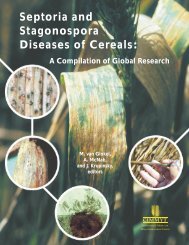Teosinte Distribution in Mexico - CIMMYT: Seeding innovation ...
Teosinte Distribution in Mexico - CIMMYT: Seeding innovation ...
Teosinte Distribution in Mexico - CIMMYT: Seeding innovation ...
Create successful ePaper yourself
Turn your PDF publications into a flip-book with our unique Google optimized e-Paper software.
20 <strong>Teos<strong>in</strong>te</strong> distribution <strong>in</strong> <strong>Mexico</strong><br />
population was not rediscovered until the early 1980s<br />
(Doebley 1983), despite attempts to f<strong>in</strong>d it <strong>in</strong> the<br />
1960s (Wilkes, personal communication). In addition,<br />
Coll<strong>in</strong>s (1921) found teos<strong>in</strong>te <strong>in</strong> maize and oat fields<br />
on the outskirts of Chalco, state of <strong>Mexico</strong>. In the<br />
state of Jalisco he found perennial teos<strong>in</strong>te <strong>in</strong> the<br />
same location reported by Hitchcock <strong>in</strong> 1910, namely<br />
1.6 km south of the Zapotlán tra<strong>in</strong> station (today<br />
Ciudad Guzmán).<br />
Bukasov (1926) visited different regions of <strong>Mexico</strong> to<br />
become acqua<strong>in</strong>ted with teos<strong>in</strong>te areas. He concluded<br />
that little was to be found <strong>in</strong> northern <strong>Mexico</strong> and<br />
that, based on the literature, there was more <strong>in</strong><br />
Durango, San Luis Potosí, the Valley of <strong>Mexico</strong>,<br />
Guanajuato, Jalisco, Hidalgo, and Chiapas.<br />
Wellhausen et al. (1951) presented a map of teos<strong>in</strong>te<br />
distribution <strong>in</strong> <strong>Mexico</strong>. Unfortunately no text<br />
accompanies the map, nor are the precise locations of<br />
teos<strong>in</strong>te <strong>in</strong>dicated.<br />
Wilkes (1967) mentioned that Coll<strong>in</strong>s, Kempton and<br />
Stadelman visited the Western Sierra Madre <strong>in</strong><br />
Chihuahua <strong>in</strong> 1937 and located teos<strong>in</strong>te at Cerro<br />
Prieto and Nabogame, places also mentioned by<br />
Lumholtz (1902). Wilkes traveled throughout <strong>Mexico</strong><br />
and found teos<strong>in</strong>te at most sites where it had<br />
previously been recorded or collected. In addition to<br />
his collections, he prepared a map (Wilkes 1967 1977b<br />
and 1985) of teos<strong>in</strong>te sites from southeastern<br />
Honduras to northern <strong>Mexico</strong>. For some of the po<strong>in</strong>ts,<br />
the place name is not mentioned.<br />
Based on his searches dur<strong>in</strong>g 1977-1980, Guzmán<br />
(1982) described the distribution of teos<strong>in</strong>te <strong>in</strong> the<br />
state of Jalisco. Five locations are identified for Zea<br />
diploperennis, four for Zea perennis, and seven for<br />
annual teos<strong>in</strong>tes.<br />
Wilkes (1986) recorded the rediscovery of teos<strong>in</strong>te at<br />
two locations <strong>in</strong> the state of Oaxaca. The first is<br />
Loxicha, also known as San Agustín Loxicha, where<br />
teos<strong>in</strong>te was first reported among herbarium<br />
specimens collected by Danish botanist Fredrick<br />
Liebmann <strong>in</strong> 1842. This population is small (less than<br />
2 km2) and seeds were collected on the outskirts of<br />
Loxicha at 1,200 meters above sea level (masl). The<br />
second population was discovered <strong>in</strong> 1985 by José M.<br />
López, of the Postgraduate College at Chap<strong>in</strong>go near<br />
San Pedro Juchatengo at 1,150 masl (Hernández X.<br />
1987).<br />
Unfortunately, specific sites are not mentioned <strong>in</strong><br />
most older reports, nor are maps <strong>in</strong>cluded to allow<br />
the location of teos<strong>in</strong>te populations. Despite the<br />
efforts of different collectors, no teos<strong>in</strong>te has been<br />
found recently <strong>in</strong> the states of Chiapas, Sonora,<br />
Hidalgo, San Luis Potosí, nor the “Barranca Chica”<br />
population near the city of Guadalajara, <strong>in</strong> the state of<br />
Jalisco.<br />
The most complete maps of teos<strong>in</strong>te distribution <strong>in</strong><br />
<strong>Mexico</strong> are those published by Kato (1976) and<br />
Sánchez and Ordaz (1987).<br />
Detailed descriptions of teos<strong>in</strong>te<br />
areas<br />
The <strong>in</strong>formation that follows is based largely on the<br />
work of Sánchez and Ordaz (1987), as well as<br />
exploration by Sánchez and Aguilar dur<strong>in</strong>g<br />
1987-1991, Wilkes and Sánchez (1993), Wilkes and<br />
Taba (1993), and Sánchez and Chuela (1995). Table 1<br />
lists the locations of populations for which seed or<br />
herbarium specimens exist or for which ethnobotanic<br />
<strong>in</strong>formation is available. <strong>Teos<strong>in</strong>te</strong> distribution areas<br />
<strong>in</strong> <strong>Mexico</strong> may be divided as follows (Fig.␣ 1).<br />
Valley of Nabogame, Chihuahua<br />
This is a small (approximately 50 km2) valley at 26°<br />
15’ N, 106° 58’ W, <strong>in</strong> the Western Sierra Madre,<br />
approximately 16 km northwest of Guadalupe and<br />
Calvo, <strong>in</strong> southern Chihuahua (Fig. 2) at an average









